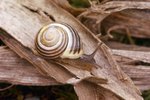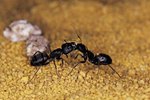
Earthworms perform a vital function in our ecology. As they burrow through the soil, they create air pockets to help plant roots breathe efficiently. Earthworms eat decaying plant matter, excreting it as castings that serve as fertilizer for plants and help improve soil texture. Several structural adaptations make them ideal for these tasks.
Body Shape
Earthworms have a simple, but efficient, body shape. Their slightly wedge-shaped heads help create holes in the soil large enough for the bodies to push through. Earthworms' streamlined bodies flow easily through the soil, instead of being bogged down or caught up by appendages. Their small diameter keeps their tunnels narrow, ensuring they don't undermine the integrity of the soil structure above them.
Segmentation
Segmented bodies are key identifying features of earthworms as well as important structural adaptations. Many worms survive when they lose posterior segments; some even regenerate the lost segments. The main use for the segments is locomotion. When an earthworm wants to move forward, he squeezes the muscles encircling his front segments to lengthen that portion of his body. He releases those muscles and contracts some in his middle section, lengthening it temporarily, followed by muscles in his rear segments. Long muscles that run from an earthworm's anterior segments to his posterior ones help control the flow of the circular segment muscles.
Setae
Without setae to help, earthworm locomotion would be only half complete. Setae are tiny, bristle-like hairs that extend from most segments. When retracted, the setae allow the earthworm to move freely through the soil. Extended setae dig into the soil and hold the worm in place. Earthworms use setae in conjunction with their segment muscles to make burrowing easier. When they contract the muscles in their front segments, they also retract the setae from those segments so the front section of the worm can push forward. The extended setae in the middle and rear sections hold the rest of the body in place. The front ends grab the dirt with setae to hold the segments in place as the middle then the rear segments contract and release their setae to slide forward.
Mouth
Earthworms don't just open their mouths and scoop up food. Instead, an earthworm pushes his pharynx out through his mouth hole, grabs food with it and pulls the food back into the mouth. He doesn't have any teeth, so he relies on his pharynx to start "chewing" the food by breaking it into smaller pieces. Earthworms also have gizzards to help break down the food.
References
Photo Credits
-
Ryan McVay/Photodisc/Getty Images



